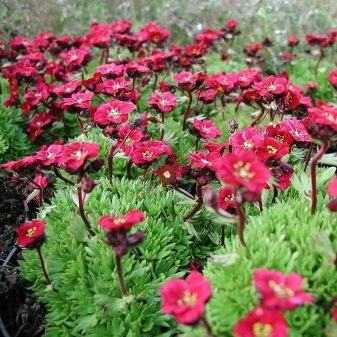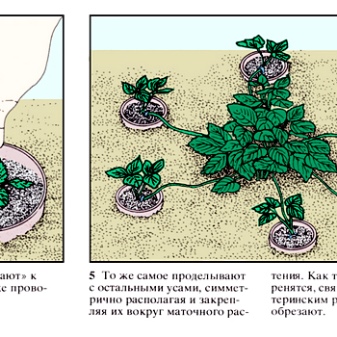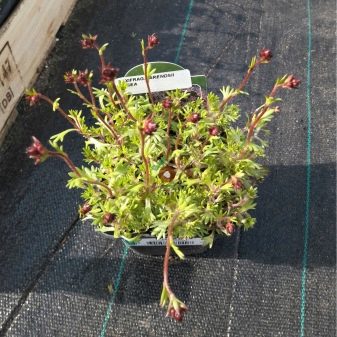Arends' saxifrage: features, planting and care

Arends' saxifrage is an evergreen plant that can grow both in a garden area and in a pot on a windowsill at home. In the article we will look at the characteristic features of the plant, as well as the rules and recommendations for caring for it.

Description
Arends' saxifrage is a plant that naturally grows in the northern regions. The required type of soil for the growth and development of a flower is stone (hence the name). From the point of view of botany, Arends's saxifrage belongs to bryophytes.
Externally, the plant consists of a rosette with branches up to 25 centimeters long, with leaves, which, in turn, can be of different shapes. Arends' saxifrage is a flowering plant. Flowers reach 10 millimeters in size and can be colored yellow, red and purple. Usually the flower consists of 5 petals and can grow in a single copy or in a group in inflorescences.
The flowering process of a plant itself lasts about a month. The flowering period is during the warm season. The specific dates depend on the variety, but the most typical time is from May to August.
Pollination of the flower is carried out by insects. The fruits are represented by capsules, inside of which there are a large number of small-sized seeds.


Varieties
The Ardens saxifrage is a fairly common plant and includes several varieties. Let's consider the most popular ones.
"Floral Carpet" (or "Flower Carpet")
This type of plant is considered large and reaches a height of up to 200 millimeters. The appearance of Arends' saxifrage of this variety is decorated with small flowers of pink, white and purple shades.

"Purple Carpet"
The variety got its name from the color of the flowers, which cover almost the entire green part of the plant.


"Peter Pan"
The plant reaches a height of no more than 150 millimeters. The color of the flowers is bright pink. The second name of the variety is soddy saxifrage. Flowering occurs in May or June for 30 days.

"Alba"
"Alba" is distinguished by small snow-white flowers and is often used for landscape design.

"Lofty" (or "Flower Courtyard")
This variety develops rather quickly. Botanists and seasoned gardeners say it takes about 8 weeks from sowing to planting in pots.

"Pink carpet"
The species got its name from the color of the flowers. It is considered one of the most popular.
As such, there is a wide variety of Arends' saxifrage varieties that differ in size and color. In this regard, each gardener will be able to choose a plant to his liking and depending on his personal needs.

Conditions of detention
Despite the fact that the flower is quite unpretentious, it needs special conditions of detention.
So, it is believed that the most correct temperature regime for saxifrage is within 20-25 degrees Celsius. In the event that you live in a hotter climate and the air temperature reaches higher values, then it is important to ensure regular ventilation and cooling of the area in which Arends's saxifrage is kept... Otherwise, the plant may die, because by its nature it is a northern inhabitant.
Due to its origin, the flower does not require shelter for the winter, and the optimal temperature in the cold season is considered to be the thermometer, which ranges from 10 to 15 degrees Celsius.
Lighting also plays an important role in keeping Arends' saxifrage. It should be noted that the plant is not light-loving and prefers partial shade. In the event that the flower is kept in the sun (especially in conditions of exposure to direct sunlight), spots may appear on its surface, and the color of leaves and flowers will significantly lose their brightness and fade.


On the other hand, it is not recommended to keep the plant in complete darkness - in such conditions it will die. If you plan to keep Arends' saxifrage on a windowsill or balcony, then it is advisable to choose the east or west side.
How to plant?
It is important to note that planting a plant can be carried out both in the open ground (in a garden plot) and in a pot for keeping indoors. One way or another, special attention must be paid to the structure of the soil - it is believed that it should be as light as possible and consist of a large amount of sand. It is also recommended to add a small amount of limestone to the ground. That's why if you are planting at home, then you should purchase ordinary soil of a universal type or make a soil collection yourself - for this it is enough to connect the sod land, coarse sand, peat (or humus). The proportions required for compliance are 1: 1: 2.
If the planting is carried out in a summer cottage or garden plot, then the most suitable place will be a slope or crevice.

However, before planting seeds in the ground, it is necessary to carry out a special preliminary procedure - stratification. Seed stratification is the process of keeping seeds in a humid environment at a low temperature. The recommended period of the procedure is from 2 weeks to 1 month. Such manipulation activates embryonic sleep, after which the phase of active germination begins.
How to care?
In order for the plant to grow and develop correctly and actively, it is important to follow simple rules of care and cultivation. If you adhere to the recommendations of experts, then the Ardens saxifrage will become a real decoration of your home flower garden.
Arends's saxifrage, just bought and brought to the house from the flower market, requires special attention. To begin with, you should remember that you should only buy a rooted shoot, which must immediately be placed in partial shade. It is also important to inspect a new plant for the presence of insect pests and external diseases.
Once the plant has become accustomed to the indoor climate of your home, it should be transplanted. However, this should be done through the procedure for cleaning the roots from old soil. Do not under any circumstances use the simple transfer method.
Before replanting the plant, take care of the presence of a suitable-sized flower pot, on the bottom of which a dense layer of drainage should be laid (expanded clay is most often used for this purpose, however, you can take other material).


Helpful Hint: Arends's saxifrage can be grown not only in flower pots, but also in pots. Thus, with the help of a plant, you can decorate and green any room.
After a new plant has taken root, it is important to maintain water balance. The watering procedure, in particular its regularity, will vary depending on the season. One way or another, it must be taken into account that the soil in the pot should be moistened only after its top layer has dried at least 20-30 millimeters.
So, in the summer, Arends's saxifrage needs watering at intervals of 1 time in 2-3 days, in winter, a schedule including 1 watering in 7-9 days will be enough.
Among other things, during the watering process, it is important to ensure that the water does not stagnate in the pot - then decay processes will begin. In the opposite case - if watering is not enough - then on the soil surface you will find pronounced spots of brown color, and you will also notice a significant increase in the size of flowers. If you see the manifestation of such signs, then it is imperative and in the shortest possible time for you to revise the irrigation schedule.
But it should also be borne in mind that in especially hot periods (especially at the moment when the air humidity indicator significantly decreases), the spraying procedure should be carried out and the leaves of the plant should be wiped with a damp cloth.


In order to improve the decorative qualities of a flower, it is recommended to apply fertilizers to the soil. It is important to carry out such procedures in summer and spring with a regularity of 1 feeding per month. It is allowed to use universal mineral compositions as additives.
Reproduction
It is believed that the most popular breeding options for Arends saxifrage are the rosette method and the cuttings method.
Socket method
In order to ensure the propagation procedure in this way, you will have to prepare a separate flower pot, which will be filled with the soil necessary for growing the Ardens saxifrage (its composition is described above), but no plants should grow in it.
Such a pot should be placed next to the one in which an already mature flower lives. Several tendrils must be removed from an adult plant into a new pot of soil. Moreover, this procedure must be carried out in such a way that the sockets on them are in the very center.
Gradually, the rooting process takes place, after which the antennae are cut off, and new young shoots grow separately.


Cutting method
Reproduction in this way can only be done when the mother plant has faded (usually in autumn). The outlet pillow must be divided into small equal parts (10-20 millimeters each) and planted in a separate pot.
This pot should be placed in a dark place and covered. As a covering material, you can use glass or film (most often they take ordinary food). After the rooting procedure is over (usually at this moment you will notice the appearance of young side outlets), the film can be removed, and the plants themselves can be planted in separate individual containers.


Diseases and pests
As a result of the mistakes and inattention made in the process of care and cultivation, the plant can experience various negative consequences and diseases.
- So, with too frequent and abundant watering, decay processes can begin. On the other hand, insufficient moisture will cause black spots to appear on the surface of Arends' saxifrage.
- If spraying is not carried out in a timely manner, then the wilting of the flower can be observed.
- When the plant does not emerge after sowing, it is highly likely that you used expired raw materials.


In addition, Arends' saxifrage is prone to diseases such as:
- rust;
- powdery mildew;
- cercosporella.
If the first signs of disease appear, it is necessary to remove the affected areas.
To control pests (ants, spider mites, thrips, aphids and others), chemical agents (insecticides and acaricides) should be used.


For growing saxifrage at home and in the garden, see the next video.

































































































The comment was sent successfully.